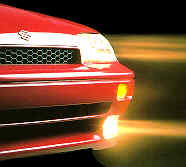|
|
The Suzuki Swift GTi
Econohuck. Flyweight supercar. Call it what you will. The Swift GTi has landed and it's destined to recalibrate your attitude about sport coupes without laying waste to your bank account. Right up front, we'll tell you the Swift GTi isn't for everybody. It certainly isn't for your Aunt Harriet or maybe even your older brother who thinks station wagons are just spiffy. Who is it for exactly? We'll tell you. 
It's for the kind of driver who prefers a stretch of twisty road to an arrow straight interstate. It's for the kind of driver who appreciates performance. And we don't mean tire smoke at the stoplight and fuzzy dice hanging from the mirror. We're talking balanced performance -- where the engine, chassis, suspension, steering, brakes, and a no-nonsense cockpit are all equally important ingredients of the complete formula. One is no good without all the rest. It's for the kind of driver who not only appreciates leading-edge automotive technology, but actively pursues it. It's also for the kind of driver who doesn't expect to spend a king's ransom. If you're still reading this, we think we're talking your language. And if we are, that language includes words like purposeful, driver-oriented, fun-to-drive, gives you a tingle even when it's just sitting in you driveway -- well, we could go on. And we will. But not just yet. Let's take a look at the exterior of this puppy first. 
From its flush headlights to the body-colored rear bumper, the Swift GTi is as aerodynamically clean as an artillery shell. The Seift GTi's drag coefficient of 0.32 is right down there with some of the best and most expensive sports cars on the planet. Ditto for its coefficient of lift of 0.08. Those outstanding numbers were achieved by extensive wind tunnel testing and carefully shaping the exterior. You'll notice the flush door handles and streamlined side mirrors. Also notice the deep front air-intake ducts. Like all the expensive Euro-Bahnburners, the Swift GTi aspirates air to cool the radiator from an area below the bumber. Inhaling cool air for the motor from as low to the ground as possible makes good aerodynamic sense. It reduces air turbulence over the hood and windshield, thus reducing wind noise. We could go on with the aerodynamic details, but hey, there's so much to cover. Check out the Tech Page for more details. 


|